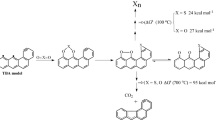Abstract
The formation of SiO(g) from SiC by either active oxidation or an oxidation-reduction process is discussed. The Wagner criterion for the transition from active to passive oxidation is generalized for any oxidant. Kinetic modeling of both active oxidation and oxidation-reduction is described.
Similar content being viewed by others
Abbreviations
- α:
-
\((MW_{O_2 } - MW_C )/MW_{SiO_2 } \)
- β:
-
\(MW_{O_2 } /MW_{SiO_2 } \)
- γ:
-
MW SiC/MW Si
- δCO :
-
CO(g) boundary layer thickness
- δox :
-
gaseous-oxidant, boundary layer thickness
- ζ:
-
stoichiometric factor from Eqs. (2)–(4), # of CO produced/# of oxidant (on oxygen atom basis)
- ν:
-
gas viscosity
- ϱ:
-
concentration of diffusing gas species in boundary layer
- ϱ′:
-
concentration of major gas species in boundary layer
- ϱoxide :
-
density of SiO2
- D :
-
diffusion coefficient of diffusing species in gas-boundary layer
- D CO :
-
diffusion coefficient of CO(g)
- D ox :
-
gas diffusion coefficient of oxidant
- J :
-
flux, rate of weight loss limited by diffusion in gas-boundary layer
- J CO :
-
flux of CO(g)
- J ox :
-
flux of gaseous oxidant
- K g :
-
linear oxide growth constant, weight/(length2 time)
- k ′ g :
-
linear oxide growth constant, length/time
- k l :
-
linear volatilization constant for SiO2,k lo+k ls, weight/(length2 time)
- k lo :
-
linear volatilization constant for oxygen from SiO2, weight/(length2 time)
- k ls :
-
linear volatilization constant for silicon from SiO2, weight/(length2 time)
- k ′ l :
-
linear volatilization constant for SiO2, length/time
- k p :
-
parabolic oxide growth constant, weight2/(length4 time)
- k ′ p :
-
parabolic oxide growth constant, length2/time
- L :
-
sample length parallel to gas flow direction
- (ΔM/A)1 :
-
specific weight change due to oxygen gain and associated carbon loss in paralinear oxidation
- (ΔM/A)1L :
-
limiting value of weight change due to oxygen gain and associated carbon loss in paralinear oxidation
- (ΔM/A)2 :
-
specific weight change due to silicon loss and associated carbon loss in paralinear oxidation
- MW C :
-
molecular weight of carbon
- \(MW_{O_2 } \) :
-
molecular weight of O2
- MW Si :
-
molecular weight of silicon
- MW SiC :
-
molecular weight of silicon carbide
- \(MW_{SiO_2 } \) :
-
molecular weight of silica
- n :
-
number of oxygen atoms per oxidant molecule
- P eqCO :
-
eqiilibrium CO(g) pressure
- P gCO :
-
CO(g) pressure outside of boundary layer
- P iCO :
-
CO(g) pressure at SiC-gas interface
- P gox :
-
oxidant gas pressure outside of boundary layer
- P iox :
-
oxidant gas pressure at SiC-gas interface
- R :
-
gas constant
- t :
-
time
- T :
-
absolute temperature
- v :
-
linear gas velocity
- x :
-
oxide thickness
- x L :
-
limiting oxide thickness achieved in paralinear oxidation
- x t :
-
oxide thickness at which transition from linear to parabolic growth occurs
References
N. S. Jacobson,J. Am. Ceram. 76, 3–28 (1993).
D. P. Butt, R. E. Tressler, and C. G. Pantano,Ind. Heat. 58, 44–48 (1991).
H.-E. Kim and D. W. Readey, inSilicon Carbide '87, J. D. Cawley and C. E. Semler (eds.) (American Ceramic Society, Westerville, OH, 1987), pp. 301–312.
T. Narushima, T. Goto, Y. Yokoyama, Y. Iguchi, and T. Hirai,J. Am. Ceram. Soc. 76, 2521–2524 (1993).
J. E. Antill and J. B. Warburton,Corros. Sci. 11, 337–342 (1971).
C. Wagner,J. Appl. Phys. 29, 1295–1297 (1958).
S. C. Singhal,Ceram. Int. 2, 123–130 (1976).
E. A. Gulbransen,Oxid. Met. 4, 181–201 (1972).
T. Narushima, T. Goto, and T. Hirai, inCorrosion and Coating of Advanced Materials, MRS Intl. Mtg. on Adv. Mats. Vol. 4 (Materials Research Society, 1989).
T. Narushima, T. Goto, Y. Iguchi, and T. Hirai,J. Am. Ceram. Soc. 74, 2583–2586 (1991).
N. S. Jacobson and R. A. Rapp, NASA Technical Memorandum 106793, 1995.
N. S. Jacobson, A. J. Eckel, and A. K. Misra,J. Am. Ceram. Soc. 73, 2330–2332 (1990).
W. M. Kays and M. E. Crawford,Convective Heat and Mass Transfer, 2nd ed. (McGraw Hill, New York, 1980), p. 139.
W. L. Vaughn and H. G. Maahs,J. Am. Ceram. Soc. 73, 1540–1543 (1990).
C. S. Tedmon, Jr.,J. Electrochem. Soc. 113, 766–768 (1967).
C. A. Barrett and A. F. Presler, NASA Technical Note D-8132 (Washington, DC, 1976).
M. J. Maloney and M. J. McNallan,Met. Trans. 16B, 751–761 (1985).
J. T. Porter, private communication.
J. E. Antill and J. B. Warburton, in North Atlantic Treaty Organization, Advisory Group for Aerospace Research and Development, Conference Proceedings No. 52,Reactions between Gases and Solids, 1970.
W. Bremen, A. Naoumidis, and H. Nickel,J. Nucl. Mater. 71, 56–64 (1977).
E. J. Opila,J. Am. Ceram. Soc. 77, 730–736 (1994).
J. A. Costello and R. E. Tressler,J. Am. Ceram. Soc. 69, 674–681 (1986).
D. S. Fox, inCeramic Engineering and Science Proceedings, Vol. 13 (The American Ceramic Society, Westerville, OH, 1992).
T. Narushima, T. Goto, and T. Hirai,J. Am. Ceram. Soc. 72, 1386–1390 (1989).
B. E. Deal and A. S. Grove,J. Appl. Phys. 36, 3770–3778 (1965).
C. E. Ramberg, M.S. thesis (Pennsylvania State University, Department of Materials Science and Engineering, 1992).
Author information
Authors and Affiliations
Rights and permissions
About this article
Cite this article
Opila, E.J., Jacobson, N.S. SiO(g) formation from SiC in mixed oxidizing-reducing gases. Oxid Met 44, 527–544 (1995). https://doi.org/10.1007/BF01051042
Revised:
Issue Date:
DOI: https://doi.org/10.1007/BF01051042




